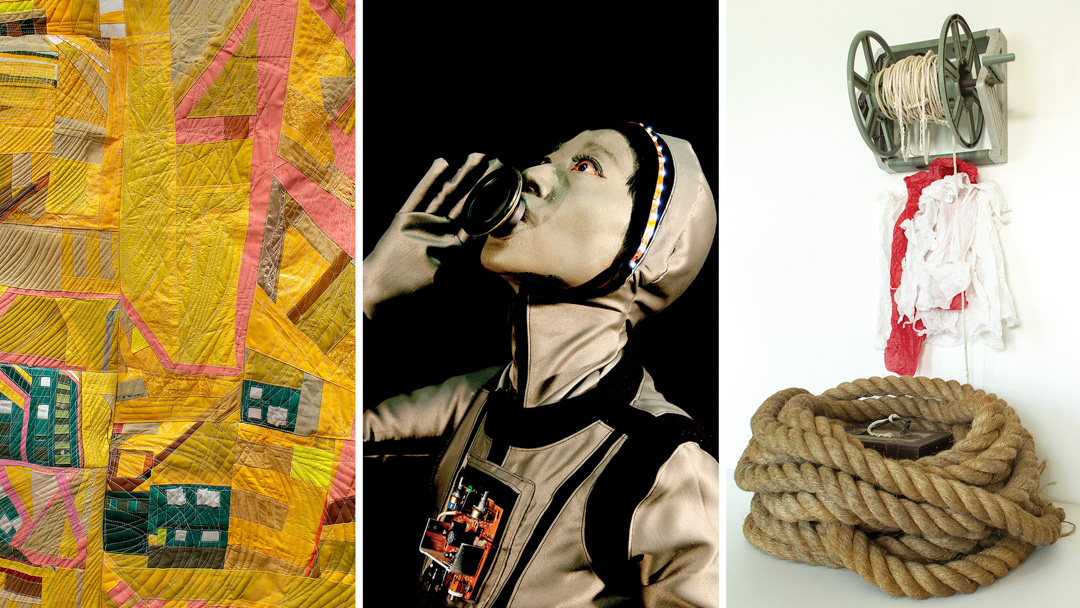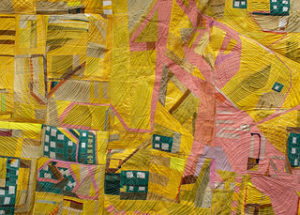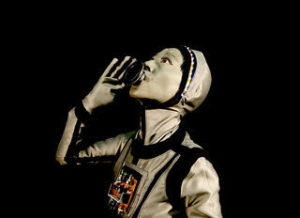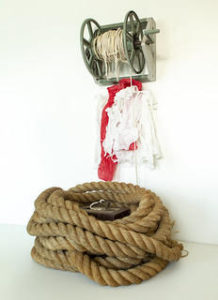
August 14, 2019
FOR IMMEDIATE RELEASE
San Francisco, CA–The Artist in Residence Program at Recology San Francisco will host an exhibition and reception for current artists-in-residence Mansur Nurullah, Genevieve Quick, and San Francisco Art Institute student artist Ariel Huang on Friday, September 20, from 5-8pm and Saturday, September 21, from 1-3pm. Additional viewing hours will be held on Tuesday, September 24, from 5-7pm, with a gallery walk-through with the artists at 6pm. This exhibition will be the culmination of four months of work by the artists who have scavenged materials from the dump to make art and promote recycling and reuse. An artwork created by Skidmore College student artist Adam Baron during his two-month special summer residency will also be shown.
Mansur Nurullah 
Errant Threads
Mansur Nurullah makes intricate, large-scale textile works that reference travel and navigation, often representing his own journeys—both literal, as someone who uses a bike for transportation, and metaphorical, as an artist and counselor who came to these careers through non-traditional paths. At Recology, Nurullah, who grew up in Chicago, examines his maternal great-grandparents’ migration to that city and the episodes of racial violence in the Jim Crow South that drove them there. He depicts their imagined trek in a 6-by-9-foot quilted, abstract work composed of materials including welding curtains, awnings, upholstery, leather, and firemen’s uniforms, connected by immersive layers of sewn lines.
The lower left portion of the work represents the 1921 Greenwood Massacre in Tulsa, Oklahoma; the lower right portion represents the 1918 lynchings of 2 men and 2 pregnant women in Meridian, Mississippi. In the center top are astronomical symbols that serve as guides to the north. Nurullah has embedded objects that acknowledge shame and the use of silence as a coping strategy in the piece, and has quilted in aromatic plants as a healing practice. His layered top stitching contributes to the sensation of restlessness, anxiety, and uncertainty. Though specific to his family, the work speaks to a larger story of racial violence in the United States and the trans-generational impact of such trauma.
A second body of work has come from experiments rusting metal on fabric to create mementos of scavenged objects. Nurullah has wrapped gratings, rotors, muffin tins, saws, and other scavenged items with sailcloth, wetting the materials and leaving them outside to create patterns on the fabric. Red and brown markings form abstracted fields, and the colors and process relate to Malian bambaran, or mud cloth, which is made with iron-rich clay. In some cases Nurullah has then cooked the fabric in crockpots with fennel and eucalyptus for an overlay of black tones and fine lines. Another piece combines unusual found materials, including drum heads, rattan from chair seats, and parking signs.
Nurullah has exhibited at Lost and Foundry in Oakland, and in San Francisco at the SF Arts Education Gallery at Minnesota Street Project, Guerrero Gallery, and Dependable Letterpress. His work is in the collection of Capital One Bank in San Francisco. In 2017, he was a San Francisco Arts Commission Gallery Passport artist. He holds a B.A. from the University of New Mexico, an M.S. in Counseling and a Counseling Credential from San Francisco State University. Prior to his work as a counselor at the San Francisco Unified School District alternative school site, he drove a cab in San Francisco for seven years.
 Genevieve Quick
Genevieve Quick
Remote Speaker
Genevieve Quick envisions a new universe, complete with its own cosmology, as a way to think about global manufacturing, technology, communication, culture, and transnationality here on planet earth. In an immersive installation that includes audio, video, and interactive components, Quick references an Asian Futurism that rejects clichés about technology and Asian cultures, and instead envisions a completely unique galactic existence. Hacking into consumer electronics, Quick reconfigures them to create work that is playful and charmingly fantastic, yet deals with larger issues.
Exhibition visitors will be voyagers into this universe, and will travel routes through a circuit board-like installation, created from Wii pads and other floor sensors that will trigger sound and videos. Two characters will serve as guides, and each has a unique communication ability; one can touch electronics and learn and share their histories, while the other sends out messages into space via eclectic methods. Quick’s work addresses communication on all levels—from megaphones, answering machines, and the voice of Siri, to communication across oceans, through the air and into space via ships, planes and satellites.
Quick has sewn elaborate costumes for the characters that incorporate speakers and other devices, and has referenced Asian warrior armor, as well as familiar Star Wars figures. She employs what she refers to as “dumb” mash-ups of technologies. But, despite this description, there is nothing simple about the work or Quick’s skills in creating this fantastical universe from scavenged materials.
Quick has exhibited at the Korean Cultural Center in New York, and in the Bay Area at the Asian Art Museum, Mills College Art Museum, Southern Exposure, The Lab, Gallery Paule Anglim, and Works San Jose. She is the recipient of a Kala Fellowship, and grants from the San Francisco Arts Commission and the Center for Cultural Innovation. She has been an artist-in-residence at the deYoung Museum, the Djerassi Resident Artist Program, A+P+I Residency at Mills College, as well as at Yaddo in New York State and the MacDowell Colony in New Hampshire. She holds an M.F.A. from the San Francisco Art Institute.
Ariel Huang brings Taiwanese urban legends to San Francisco in a series of interactive, kinetic sculptures. The legends, which often take place in the mountains or at the ocean, tell the stories of spirits who need to be guided by Heibai Wuchang (黑白無常, literally “black and white impermanence”), to be released from their earthly haunts.
Huang’s work tells the stories of the dead who walk the shoreline, and spirits who communicate through Ouija boards. She also references familiar horror film tropes, such as haunted children’s toys. Huang includes sound and video in the sculptures, and has built her haunted machines using motors and audio components pulled from scavenged electronics. She sees the work as a conversation between cultures, and draws parallels between the objects that need to be let go of at the dump and the ghosts who need to be freed.
Huang will receive a B.F.A. from the San Francisco Art Institute in August with a major in Art and Technology. She has worked as an assistant animator and character designer in Los Angeles, and has exhibited at the Untitled Art Fair in San Francisco, and APAture 2018.
When:
Reception-Friday, September 20, 2019, 5-8pm
Reception-Saturday, September 21, 2019, 1-3pm
Additional viewing hours-Tuesday, September 24, 2019, 5-7pm with gallery walk-through with artists at 6:00pm at 401 Tunnel Avenue
Where:
Art Studio, 503 Tunnel Avenue and Environmental Learning Center, 401 Tunnel Avenue, San Francisco, CA
Admission is free and open to the public, all ages welcome, wheelchair accessible.
About the Recology Artist in Residence Program
The Artist in Residence Program at Recology San Francisco was established in 1990 to encourage the conservation of natural resources and instill a greater appreciation for the environment and art in children and adults. Artists work for four months in studio space on site, use materials recovered from the Public Reuse and Recycling Area, and speak to students and the general public. Over 190 Bay Area artists have completed residencies. Applications are accepted annually, June through August.
Contacts:
Deborah Munk
dmunk@recology.com
Micah Gibson (for hi res images)
mgibson@recology.com
Sharon Spain
sspain@recology.com
####
